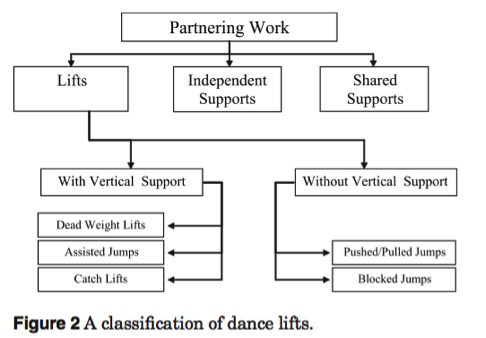By Sylvain Lafortune
It is important to realize that during a lift, the partners are no longer individuals but are part of a single architectural unit with a common center of gravity and a common base of support.”
Classification of Lifts:
Static: if both dancers stay in place
- Straight lift: when both partners stay in place
Dynamic: if at least one is moving
- Transport:when both partners travel together
- Crossover:when the lifter stays in place while the liftee travels, typically across the lifter’s base of support.
- Parallel: if both partners move together in the same direction;
- Convergent: if one or both partners are mov- ing toward each other during the preparation Divergent: if one or both are moving away from each other during the conclusion.
Vertical Support Lifts:
- A dead weight lift in which the liftee does not jump at all;
- An assisted jumpin which the liftee jumps with the help of the lifter; and
- A catch lift in which the liftee jumps alone and is caught in the air.
Horizontal Support Lifts:
- Pushed or pulled jump: the lifter affects the liftee’s jump from the start, similar to an assisted jump but with only horizontal force applied
- Blocked jump:the lifter affects the liftee’s jump after it is in the air, similar to a catch lift but with only horizontal force applied.
Phases:
- Preparation: all the movements preceding the support that will have a direct mechanical impact on the rest of the lift.
- Loading:when the lifter gradually takes control of the weight of the liftee. The loading starts when the lifter begins to support the liftee’s weight, typically before the liftee is actually off the ground, and ends when the lifter’s support reaches its maximum.
- Suspensionis the central part of a lift, its defining image.
o Stable suspension: the common center of gravity is aligned over the base of support. It then can be held in position indefinitely. In these situations, the suspension is the moment when the lifter has complete control of the weight of the liftee. As long as the lifter keeps the control of the weight of the liftee, the lift is in its suspension phase even if the height and configuration of the liftee change.
o Temporary suspension: the center of gravity is not aligned over its base of support. It cannot be held in position, no matter how strong the lifter or how light the liftee. In these situations, the suspension is the instant between the loading and the unloading, at the apex of the aerial trajectory of the liftee.
- Unloading: when the lifter gradually gives back to the liftee the control of her own weight. It ends when the lifter no longer applies a vertical force on the liftee. Like the loading phase, the unloading is not defined by the contact of the liftee with the floor since the lifter often continues to apply a vertical force after the landing.
- Conclusion: all the movements that are mechanically affected by the lift after the unloading phase. It starts when the lifter no longer applies vertical force but can still include the application of horizontal force to help the liftee to regain control of her action, such as leading into a run or a turn. The conclusion blends with the rest of the choreography and can become the preparation of the next lift.
Examples of Strategies for Stability
- Prehension(the act of grasping) is when the point of support is stabilized by the opposite action of the thumb and the other fingers.
- Hug:when the point of support is stabilized by the action of the arms pressing against the torso.
- Shelf: when the point of support is stabilized by the action of gravity. The weight of the liftee is resting on a body part of the lifter more or less horizontally.
- “A hold can have a combination of points of support and each point can be stabilized using different strategies. Hands can be used as shelves as well as prehensions.”
Holds:
- Transferred: point of support is added or removed without the loss of contact between the partners.
- Rolling in or rolling out: the liftee rotates on the lifter. In this case, the points of support change on both partners.
- Sliding: the liftee slides on the lifter. In this case, the points of support change for one partner but stay the same for the other.
- Interrupted: there is a loss of contact during the suspension phase such as in a toss followed by a catch.
Landing:
- Assisted landing: the liftee absorbs the force of her own fall with the help of the lifter
- Deadweightlanding: only the lifter absorbs the fall
- Free fall: the liftee absorbs her own landing (the partners lose contact while the liftee is still in the air, or, if they are still in contact, the lifter then no longer applies a vertical force).










